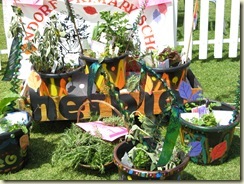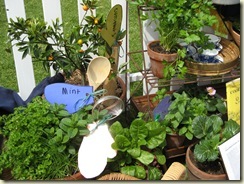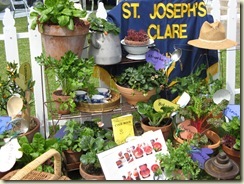There you have it.... and it was obvious all along but I just couldn't put my finger on the link.... I must be getting old....or something!
Monoculture means growing one thing, usually on a massive scale and killing everything that dares interfere with that one thing, with chemicals.
Then there was organic but often it came to mean growing one thing, on a massive scale and killing everything that interferes with it, with chemicals made from natural substances.
In the organic vegetable garden I always encourage people to make use of every little microclimate, interplanting tall things with short to get shade in the heat of summer; always having flowers and seedlings and mature plants in the same bed; feeding the soil and the plants will feed themselves..... but still I was not quite sure what to say when asked "How can we feed the world this way?"
But then there was "Fresh" the movie.... and I have the answer... its all about food being nutritious and the loop....
Monoculture is like a huge field of wheat; when the crop is taken, there is nothing left. The farmer must get the land ready for next year by fertilising, spraying for pest and weeds, fixing machinery and buying seed. He spends many thousands of dollars on inputs from all over the world, which are trucked and shipped and give me a headache thinking about. Lets say that after expenses, he makes $100 / acre for his wheat crop if it is a good crop and if prices are good.
Then lets look at the kind of farmer shown in "Fresh" who has several fields of mixed grasses which soon self seed every year. First he puts cows on the field. Cows eat grass and grow big. Every few days he moves the cows to the next field, then the next and so on around the property. As the cows go along they fertilise the grasses but they also attract flies which lay their eggs in the dung, and flies carry diseases which can quickly spread through the cows when they come back to this pasture. Eventually he sells the cows for meat, to a local butcher. It is organic and of excellent quality and he might get $100 / acre. His cows had calves and so his next generation is produced.
Second, 3 days after the cows are taken off he lets in the chickens to the first field. The fly and other insect eggs have hatched and the chickens are in rapturous delight and gorge themselves, laying big, healthy, nutritious eggs for the farmer to sell. From these large, organic eggs the farmer receives $100 / acre from the local organic food shop or from the farm gate. Some of the eggs are allowed to hatch and become the next generation.
Third, in come a host of meat birds that eat a different selection of grasses to the cows and the chickens. Once these birds such as geese and turkeys have been through all the fields, they are sold for meat. They are healthy and strong and organic and he might get $100 / acre, sold direct to local shops. These also reproduce themselves.
Fourth, the grass is now well fertilised by cows, chickens and other birds and grows fast. The cows are allowed back in again before the grass dries and goes to seed. Now the farmer cuts it for hay. He uses some for the bedding and winter feed for his animals and sells the rest. He might receive $100 / acre from local people direct from the farm. The grasses self-seed and come up again next spring.
Moreover, some of the fields of the sustainable farmer produce a variety of vegetables at various times and some may have fruit trees under which the chickens graze in their rotation. The system is flexible and is a closed loop, with few inputs from beyond the farm. All his produce is sold locally.
Even with this simplistic view, you can see that he is producing many times the volume of more nutritious food for human consumption than the wheat farmer, whose crop is shipped around the world where it is processed and made into white flour which ends up as items wrapped in plastic bags in supermarkets thousands of kilometres away, adding little but carbohydrate to the diet to those that eat it. And it seems, from the documentary, that the multi-cultural farmer reaps the rewards financially too.
The multi-cultural farmer needs workers to help. He creates employment for locals. Those who may otherwise be driving trucks or ships of wheat, stay home and work on this farm and themselves learn the value of nutrition, raising healthy children who take their message to school and help start a school vegetable garden..... and so the effects go on and on, rippling through every avenue of society.
In this way we not only feed the world but it is sustainable, reducing greenhouse gases, climate change, pollution, medical expenses, unemployment etc etc etc and generally making the world a happier place for everyone.
Watch a trailer, join the movement, find a screening here. It is American, and I am always sceptical of American things (sorry Pattie!) but this is genuinely good and farmer whatsit who lets his chickens be chickens and develop their chicken-ness is fabulous..... as is the big, ex-basketballer turned urban farmer.


















